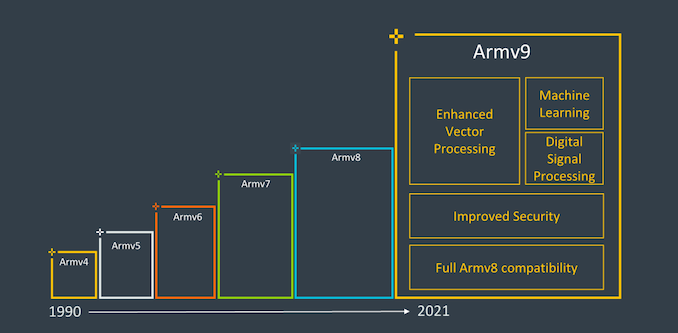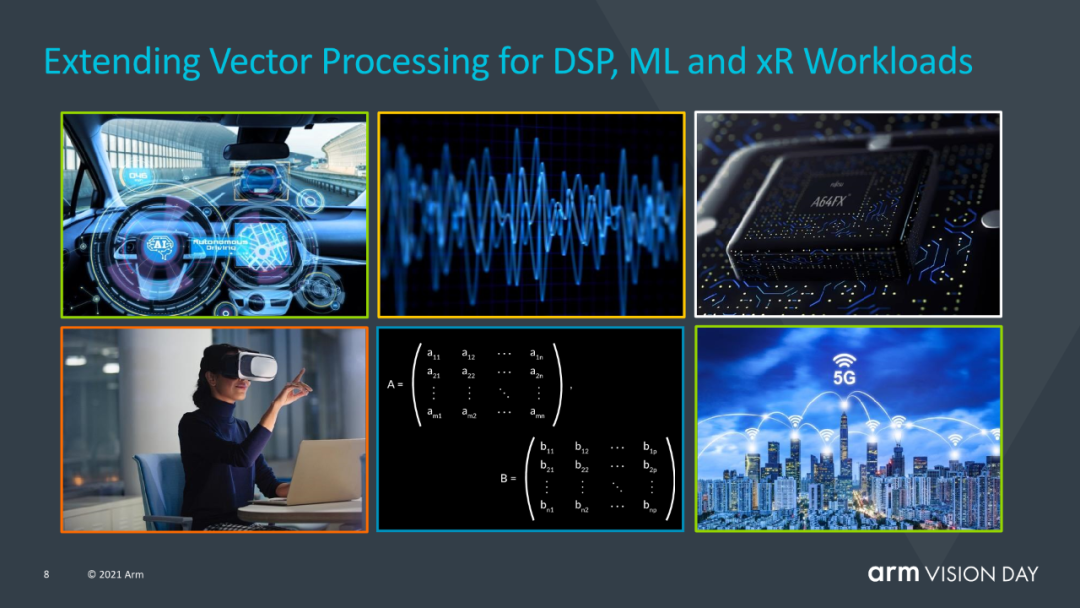ARM company’s new CPU architecture Armv9 is here.
Editor’s note: This article is from the WeChat public account “Machine Heart” (ID: almosthuman2014), editor: Dimension.
For the new Armv9 architecture, ARM CEO Simon Segars said, “The v9 architecture will enhance security and trust, and lay the foundation for computer technology in the next ten years.”
Today, ARM officially announced the launch of the new Armv9 architecture. This is the company’s first major adjustment to its CPU architecture nearly ten years after the Armv8 architecture was launched in October 2011. Over the years, ARM has been carrying out various updates and extensions to the instruction set architecture. The company said that this v9 architecture aims to provide stronger algorithm support for mobile devices, computers and servers.
The development history of the Arm architecture.
The new Armv9 architecture has three focuses, namely AI, vector and DSP performance improvement, and security. In terms of specific details, the Armv9 architecture follows the AArch64 benchmark instruction set, and adds some very important extensions in terms of functions, so as to ensure that the ARM company increases the architecture number and focuses on the new features of the v9 architecture and various v8 architecture extensions released over the years. Rebasing at the software level.
According to ARM, the Armv9 architecture will be equipped with 300 billion ARM chips in the future. And, according to the current development speed, it is estimated that the shipment of ARM devices will exceed 100 billion units in the next five years.
Unfortunately, ARM did not disclose the specific release time of the first new chip based on the Armv9 architecture. It must be a while.
Armv9 architecture laid the foundation for the CPU computing platform for the next 10 years.
Armv9 architecture new features
The new Armv9 architecture has three main focuses: AI, vector and DSP performance improvements, and security. First look at DSP and AI performance.
Extended vector processing for DSP, ML, and xR workloads.
For developers and users, the most significant feature of the new Armv9 compatible CPU is the use of Scalable Vector Extension 2 (SVE2) as the new benchmark after ARM NEON technology. SVE2 was released in April 2019 and aims to accelerate high-performance computing, with great gains in processing machine learning (ML) tasks such as 5G, virtual reality (VR) and augmented reality (AR), and image and speech recognition.
ARM believes that ML workloads will become more and more common in the next few years. Correspondingly, any performance or power-centric device needs to run ML workloads on dedicated accelerators, but most of them will still choose to use a smaller range of ML workloads running on the CPU.
The matrix multiplication instruction is the key, and it is an important step that is widely used as a benchmark feature of the Armv9 CPU.
Security
ARM hopes to solve the security problem through a new Confidential Compute Architecture (CCA). To this end, ARM has introduced a new concept-realms, which can be regarded as a secure container execution environment that is completely opaque to the operating system (OS) or hypervisor. Although the hypervisor still exists, it is only responsible for resource scheduling and allocating tasks.
In addition, the domain will be managed by a new entity “realm manager”, the code size of the domain manager is about 1/10 of the hypervisor.
The CCA architecture adopted by Armv9.
Applications in the domain will be able to verify and confirm whether the domain manager can be trusted, which is impossible for traditional hypervisors. ARM did not go into the details of what caused this separation between the operating system and hypervisor domains and non-secure areas, but it sounds like the hardware-supported address space cannot interact with each other. .
Simple and complex examples of using domains.
The advantage of using a domain is that it greatly reduces the trust chain of applications running on the device, and the operating system becomes very transparent to security issues. In addition, ARM also introduced memory tagging (Memory Tagging) expansion, which also helps eliminate security issues.
The memory label extension introduced by ARM.
Finally, ARM said that in the next two chip iterations, the Armv9 architecture will bring 30% performance improvement.
Reference link:
https://aijishu.com/a/1060000000024513
https://www.cnbeta.com/articles/tech/1108589.htm
https://finance.sina.com.cn/tech/2021-03-31/doc-ikmxzfmi9630877.shtml
https://www.anandtech.com/show/16584/arm-announces-armv9-architecture





